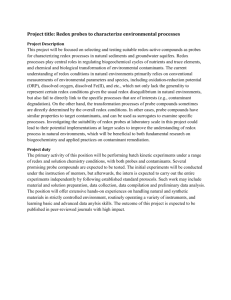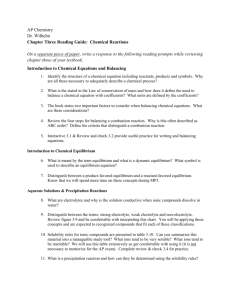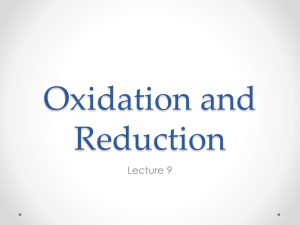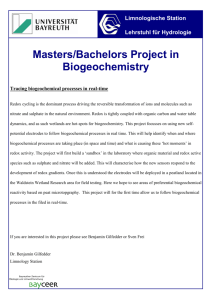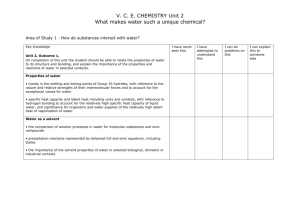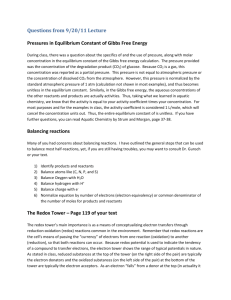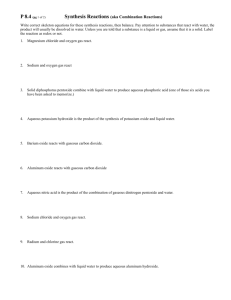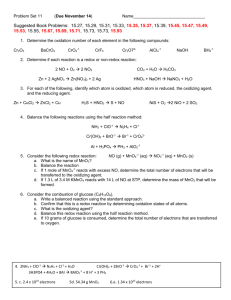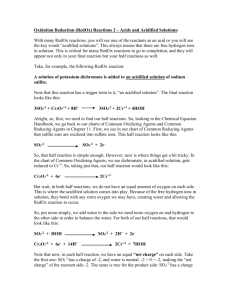Big Idea 3 Outline A. A chemical change may be represented by a
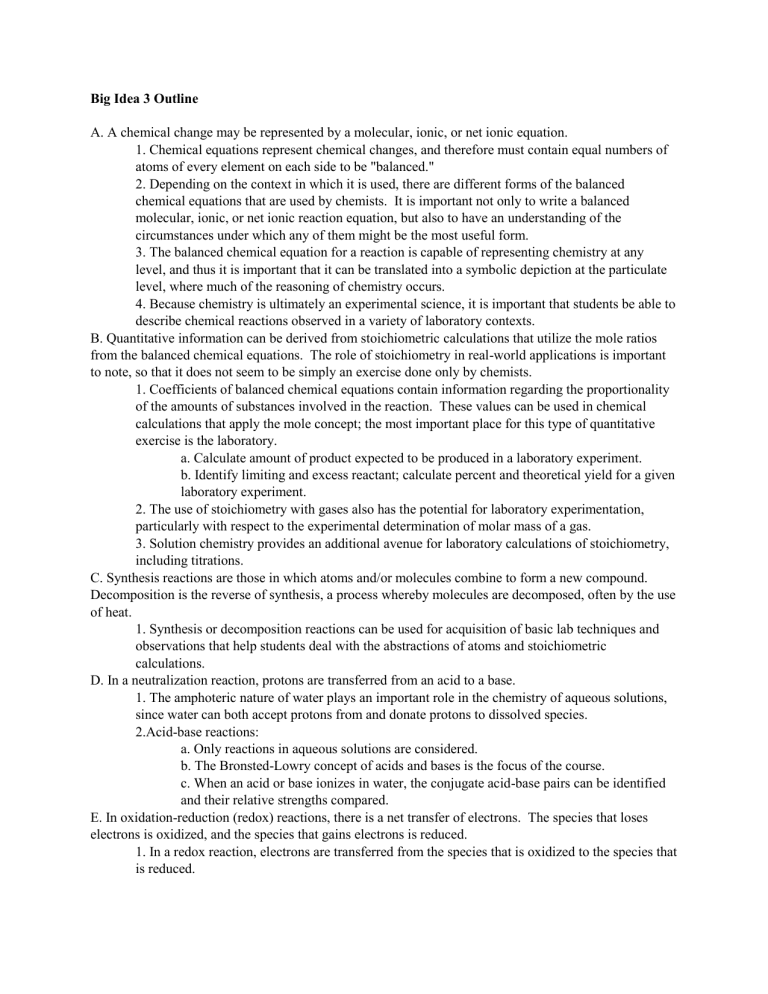
Big Idea 3 Outline
A. A chemical change may be represented by a molecular, ionic, or net ionic equation.
1. Chemical equations represent chemical changes, and therefore must contain equal numbers of atoms of every element on each side to be "balanced."
2. Depending on the context in which it is used, there are different forms of the balanced chemical equations that are used by chemists. It is important not only to write a balanced molecular, ionic, or net ionic reaction equation, but also to have an understanding of the circumstances under which any of them might be the most useful form.
3. The balanced chemical equation for a reaction is capable of representing chemistry at any level, and thus it is important that it can be translated into a symbolic depiction at the particulate level, where much of the reasoning of chemistry occurs.
4. Because chemistry is ultimately an experimental science, it is important that students be able to describe chemical reactions observed in a variety of laboratory contexts.
B. Quantitative information can be derived from stoichiometric calculations that utilize the mole ratios from the balanced chemical equations. The role of stoichiometry in real-world applications is important to note, so that it does not seem to be simply an exercise done only by chemists.
1. Coefficients of balanced chemical equations contain information regarding the proportionality of the amounts of substances involved in the reaction. These values can be used in chemical calculations that apply the mole concept; the most important place for this type of quantitative exercise is the laboratory. a. Calculate amount of product expected to be produced in a laboratory experiment. b. Identify limiting and excess reactant; calculate percent and theoretical yield for a given laboratory experiment.
2. The use of stoichiometry with gases also has the potential for laboratory experimentation, particularly with respect to the experimental determination of molar mass of a gas.
3. Solution chemistry provides an additional avenue for laboratory calculations of stoichiometry, including titrations.
C. Synthesis reactions are those in which atoms and/or molecules combine to form a new compound.
Decomposition is the reverse of synthesis, a process whereby molecules are decomposed, often by the use of heat.
1. Synthesis or decomposition reactions can be used for acquisition of basic lab techniques and observations that help students deal with the abstractions of atoms and stoichiometric calculations.
D. In a neutralization reaction, protons are transferred from an acid to a base.
1. The amphoteric nature of water plays an important role in the chemistry of aqueous solutions, since water can both accept protons from and donate protons to dissolved species.
2.Acid-base reactions: a. Only reactions in aqueous solutions are considered. b. The Bronsted-Lowry concept of acids and bases is the focus of the course. c. When an acid or base ionizes in water, the conjugate acid-base pairs can be identified and their relative strengths compared.
E. In oxidation-reduction (redox) reactions, there is a net transfer of electrons. The species that loses electrons is oxidized, and the species that gains electrons is reduced.
1. In a redox reaction, electrons are transferred from the species that is oxidized to the species that is reduced.
2. Oxidation numbers may be assigned to each of the atoms in the reactant and products; this is often an effective way to identify the oxidized and reduced species in a redox reaction.
3. Balanced chemical equations for redox reactions can be constructed from tabulated halfreactions.
4. Recognizing that a reaction is a redox reaction is an important skill; an apt application of this type of reaction is a laboratory exercise where students perform redox titrations.
5. There are a number of important redox reactions in energy production processes (combustion of hydrocarbons and metabolism of sugars, fats, and proteins).
F. Production of heat or light, formation of a gas, and formation of a precipitate and/or a color change are possible evidences that a chemical change has occurred.
1. Laboratory observations are made at the macroscopic level, so students must be able to characterize changes in matter using visual clues and then make representations or written descriptions.
2. Distinguishing the difference between chemical and physical changes at the macroscopic level is a challenge; therefore, the ability to investigate chemical properties is important.
3. In order to develop the ability to distinguish experimentally between chemical and physical changes, students must make observations and collect data from a variety of reactions and physical changes within the laboratory setting.
4. Classification of reactions provides important organizational clarity for chemistry; therefore, students need to identify precipitation, acid-base, and redox reactions.
G. Net changes in energy for a chemical reaction can be endothermic or exothermic.
1. Macroscopic observations of energy changes when chemicals react are made possible by measuring temperature changes.
2. These observations should be placed within the context of the language of exothermic and endothermic change.
3. The ability to translate observations made at the macroscopic level in the laboratory to a conceptual framework is aided by a graphical depiction of the process called an energy diagram, which provides a visual representation of the exothermic or endothermic nature of a reaction.
4. It is important to be able to use an understanding of energy changes in chemical reactions to identify the role of endothermic and exothermic reactions in real-world processes.
H. Electrochemistry shows the interconversion between chemical and electrical energy in galvanic and electrolytic cells.
1. Electrochemistry encompasses the study of redox reactions that occur within electrochemical cells. The reactions either generate electrical current in galvanic cells, or are driven by an externally applied electrical potential in electrolytic cells. Visual representations of galvanic and electrolytic cells are tools of analysis to identify where half-reactions occur and the direction of current flow.
2. Oxidation occurs at the anode, and reduction occurs at the cathode for all electrochemical cells.
3. The overall electrical potential of galvanic cells can be calculated by identifying the oxidation half-reaction and reduction half-reaction, and using a table of Standard Reduction Potentials.
4. Many real systems do not operate at standard conditions and the electrical potential determination must account for the effect of concentrations. The qualitative effects of concentration on the cell potential can be understood by considering the cell potential as a driving force toward equilibrium, in that the farther the reaction is from equilibrium, the greater the magnitude of the cell potential. The standard cell potential, E o , corresponds to the standard conditions of Q = 1. As the system approaches equilibrium, the magnitude (absolute value) of the cell potential decreases, reaching zero at equilibrium (when Q = K ). Deviations from standard
conditions that take the cell further from equilibrium than Q = 1 will increase the magnitude of the cell potential relative to E o . Deviations from standard conditions that take the cell closer to equilibrium than Q = 1 will decrease the magnitude of the cell potential relative to E o . In concentration cells, the direction of spontaneous electron flow can be determined by considering the direction needed to reach equilibrium.
5. Δ G o (standard Gibbs free energy) is proportional to the negative of the cell potential for the redox reaction from which it is constructed.
6. Faraday's laws can be used to determine the stoichiometry of the redox reactions occurring in an electrochemical cell with respect to the following: a. Number of electrons transferred b. Mass of material deposited or removed from an electrode c. Current d. Time elapsed e. Charge of ionic species


